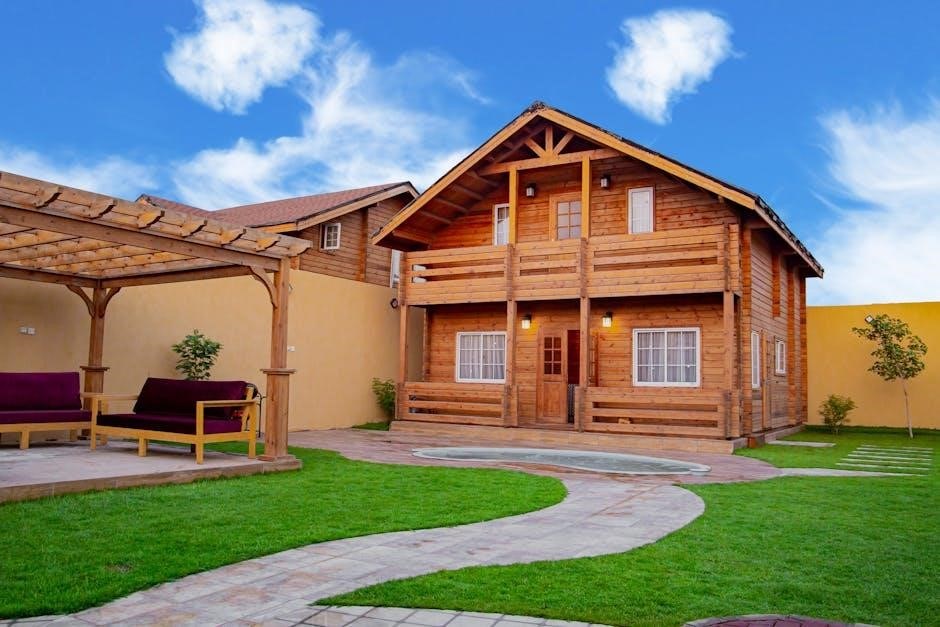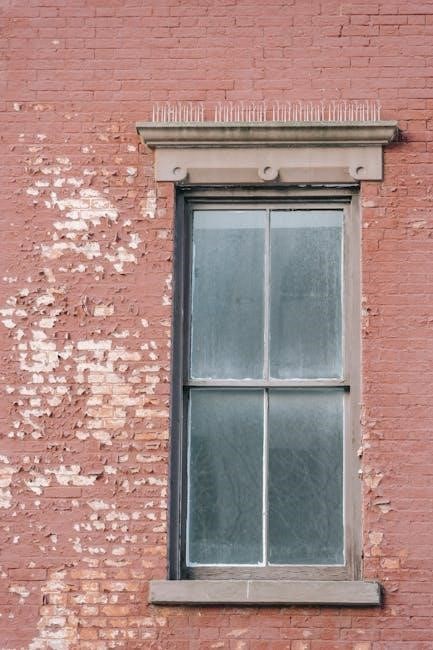A prescriptive residential deck construction guide provides standardized methods for building safe and durable decks. It outlines materials, designs, and techniques to ensure compliance with local codes.
1.1 What is a Prescriptive Deck Construction Guide?
A prescriptive deck construction guide is a standardized manual that outlines specific design, material, and building requirements for residential decks. It provides detailed instructions and diagrams to ensure safety, durability, and compliance with local building codes. The guide typically covers aspects like foundation types, framing techniques, and railing installation, offering a step-by-step approach for homeowners and contractors. By following these guidelines, builders can avoid common mistakes and ensure their deck is structurally sound and meets regulatory standards.
1.2 Importance of Following Prescriptive Guidelines
Following prescriptive guidelines is crucial for ensuring the structural integrity and safety of a deck. These guidelines are developed by experts to meet safety standards and prevent failures. They help avoid costly repairs by addressing potential issues early in the construction process. Compliance with local building codes is also ensured, which is essential for passing inspections. Additionally, adhering to these guidelines reduces liability risks and ensures the deck remains durable and safe for years to come, protecting both the property and its occupants.
Planning and Designing Your Deck
Planning involves determining deck size, layout, and materials, ensuring compliance with local codes and safety standards for structural integrity and durability.
2.1 Determining Deck Size and Layout
Determining deck size and layout involves assessing available space, intended use, and aesthetic preferences; Measure the area where the deck will be built, considering both functionality and design. Consider how the deck will integrate with the house and yard. A well-planned layout ensures efficient use of space and enhances the overall appearance of the property. Use graph paper to sketch designs and visualize the final structure before construction begins.
2.2 Choosing the Right Materials for Your Deck
Choosing the right materials for your deck is crucial for durability and aesthetics. Consider factors like climate, budget, and maintenance preferences. Pressure-treated lumber is ideal for structural components, while redwood or cedar offers natural resistance to rot. Composite decking provides low-maintenance options. Always select materials that meet local building codes and are suitable for outdoor conditions. Refer to Table 2 for allowable joist spans based on lumber size and spacing. Ensure all hardware and fasteners are corrosion-resistant for long-lasting performance.
2.3 Understanding Local Building Codes and Permits
Understanding local building codes and permits is essential for a compliant and safe deck construction. Building codes outline structural requirements, material standards, and safety guidelines. Before starting your project, obtain necessary permits to avoid legal issues. Local regulations may vary, so research your area’s specific rules. Codes typically cover deck height, railing requirements, and footing depth. Ensure your design meets these standards to pass inspections and guarantee safety. Proper documentation and approval are critical for a successful project.

Foundation and Footings
A deck’s foundation and footings are critical for stability and safety. They transfer the deck’s weight to the ground, preventing settling or shifting. Properly constructed footings ensure the deck remains level and secure over time. Footings are typically poured concrete pads or piles that extend below the frost line to avoid movement caused by freezing temperatures. Local building codes often specify footing depth and size based on soil type and deck weight. A strong foundation ensures long-term durability and safety for the deck and its users.
3.1 Types of Deck Foundations
Deck foundations vary based on design requirements and load-bearing needs. Common types include floating decks, which rest on footings without attachment to the house, and slab-on-grade foundations, suitable for low-profile decks. Pile foundations are used for larger decks or unstable soil, extending deep into the ground for stability. Each type must comply with local building codes and soil conditions to ensure structural integrity and safety. Proper foundation selection is crucial for the deck’s longevity and performance, preventing settling or structural damage over time.
3.2 Digging and Pouring Concrete Footings
Digging and pouring concrete footings is a critical step in deck construction. Begin by marking the footing locations according to your design plan. Dig holes to the required depth, ensuring compliance with local building codes. Pour concrete into the holes, using forms to shape the footings. Allow the concrete to cure fully before proceeding. Properly constructed footings provide a stable base for your deck, ensuring safety and preventing structural issues. Always check local regulations for specific requirements.
3.4 Anchoring the Deck to the House
Anchoring the deck to the house is essential for stability and safety. Use a ledger board securely attached to the house framing with lag screws. Ensure proper flashing is installed between the ledger and the house to prevent water damage. The ledger board must be level and aligned with the deck’s foundation. Follow local building codes for screw spacing and type. Proper anchoring prevents the deck from shifting or detaching, ensuring long-term structural integrity and safety for all users.
Framing the Deck
Framing the deck involves installing the ledger board, posts, beams, and joists, ensuring proper structural integrity. Decking boards are then attached to complete the deck surface.
4.1 Installing the Ledger Board
The ledger board is a critical structural component attaching the deck to the house; Ensure it is level and securely fastened using lag screws. Check local codes for specific requirements, such as flashing installation to prevent water damage. The ledger board should be positioned to align with the deck joists, ensuring proper load distribution. Use pressure-treated lumber for durability and resistance to rot. Verify the ledger board’s placement matches the deck design and framing plan for structural integrity and safety.
4.2 Setting Deck Posts and Beams
Deck posts and beams form the structural backbone of the deck, supporting the joists and decking boards. Posts should be anchored to concrete footings for stability, ensuring they are plumb and level. Beams are typically attached to the posts using post-to-beam connectors, providing additional strength. Use pressure-treated lumber for posts and beams to resist rot and insect damage. Ensure proper spacing and alignment with the ledger board for even load distribution. Always verify compliance with local building codes for sizing and spacing requirements.
4.3 Installing Joists and Decking Boards
Joists are horizontal beams that span between the ledger board and the supporting beams, creating the deck’s framework. They should be spaced evenly, typically 16 or 24 inches apart, depending on local codes. Decking boards are then attached to the joists using screws or nails. Use pressure-treated or naturally rot-resistant lumber for durability. Ensure boards are spaced 1/8 inch apart for drainage and expansion. Check for any warping and secure boards firmly to the joists for a sturdy and even surface.

Railings and Guardrails
Railings and guardrails are critical for deck safety, preventing falls and ensuring code compliance. They must be sturdy, well-designed, and constructed with durable materials like wood or metal.
5.1 Building Deck Railings
Building deck railings involves selecting durable materials like wood, metal, or composite. Measure and cut posts, attach them securely to the deck frame, and install horizontal rails. Ensure compliance with local building codes for height and spacing. Add balusters or spindles for structural support and aesthetic appeal. Finish with a sturdy cap rail for a polished look. Conduct a final inspection to ensure stability and safety, making adjustments as needed to meet code requirements and provide reliable support for years of use.
5.2 Installing Guardrails for Safety
Guardrails are essential for deck safety, preventing falls and ensuring structural integrity. Use durable materials like wood, metal, or composite for construction. Measure and cut posts to fit deck height, securing them to the frame. Install horizontal rails between posts, ensuring proper spacing and alignment. Add balusters or spindles for additional support and visual appeal. Finish with a cap rail to cover edges and enhance aesthetics. Conduct a final safety inspection to verify stability and compliance with local building codes, ensuring reliable protection for users of all ages.
Deck Stairs
Deck stairs require precise planning for safety and functionality. Determine riser and tread dimensions based on local codes and deck height. Cut stringers to fit the slope, ensuring even steps. Attach treads and risers securely, using weather-resistant fasteners. Install support brackets for added stability. Sand all surfaces for a smooth finish. Ensure stairs align with the deck frame and handrail installations. Conduct a final inspection to verify compliance with safety standards and proper construction techniques.
6.1 Designing and Building Deck Stairs
Designing and building deck stairs involves careful planning to ensure safety and functionality. Begin by determining the rise (vertical height) and run (horizontal depth) of each step, typically following local building codes. The “3-4-5 rule” can help achieve a safe slope by maintaining a ratio of 3 units of rise to 4 units of run, ensuring a comfortable and secure step. Use weather-resistant materials, such as pressure-treated wood or composite decking, to withstand outdoor conditions.
Cut the stringers, the diagonal supports, to fit the calculated slope, ensuring they are level and securely attached to both the deck and the ground. Attach treads and risers to the stringers, spacing them consistently. Sand all surfaces to eliminate splinters and rough edges. Properly anchor the stairs to the deck frame with bolts or lag screws for stability; Finally, conduct a thorough inspection to verify that all components meet safety standards and are securely fastened.
6.2 Installing Railings on Stairs
Installing railings on deck stairs is crucial for safety and compliance with building codes. Begin by attaching sturdy posts at each step and at the top of the stairs. Use materials like wood, metal, or composite that match your deck’s style. Secure horizontal rails between the posts, ensuring they are level and tightly fastened. Add balusters or spindles between the rails for additional safety, especially if the stairs are high. Sand and finish the railings to ensure a smooth surface and a polished appearance, adhering to local building regulations for height and spacing requirements.

Finishing Touches
Finishing touches complete your deck’s appearance and ensure safety. Install lighting, secure all components, and inspect for any final adjustments to ensure everything is ready for enjoyment.
7.1 Deck Lighting and Electrical Components
Deck lighting enhances safety and ambiance, while electrical components ensure functionality. Install low-voltage lighting for stairs and railings, and use weather-resistant materials. Ensure all electrical work meets local codes and safety standards. Plan lighting placement to avoid glare and ensure even illumination. Consider energy-efficient options like LED lights for durability and cost savings. Always hire a licensed electrician for complex installations to prevent hazards and ensure compliance with regulations.
7.2 Sealing and Protecting the Deck
Sealing and protecting your deck is essential to maintain its durability and appearance. Clean the deck thoroughly before applying sealants to ensure proper adhesion. Use high-quality waterproof sealants or stains to shield the wood from moisture and UV damage. Reapply sealants every 2-3 years, or as needed, to maintain protection. Regularly inspect for signs of wear or rot and address issues promptly. Protecting your deck from environmental elements ensures longevity and preserves its structural integrity for years to come.

Final Inspection and Maintenance
Conduct a thorough inspection of your deck annually to ensure structural integrity and safety. Check for rot, loose boards, and hardware wear. Address issues promptly to maintain durability and appearance.
8.1 Conducting a Safety Inspection
Regular safety inspections are crucial to ensure your deck remains structurally sound and safe for use. Start by examining the foundation and footings for any signs of shifting or damage. Check the ledger board for proper attachment to the house and inspect posts and beams for rot or insect damage. Verify that joists and decking boards are secure and free from rot. Test railings and guardrails for stability, ensuring they meet height and spacing requirements. Address any issues promptly to prevent further damage and maintain safety.
8.2 Regular Maintenance for Longevity
Regular maintenance is essential to extend the life of your deck. Clean debris and dirt from the deck surface using a mild detergent and water. Power wash if necessary, but avoid high pressure to prevent damage. Reapply deck sealant or stain annually or when signs of wear appear. Inspect for rot or insect damage and replace any compromised boards. Tighten loose fasteners and ensure all connections remain secure. Trim vegetation around the deck to prevent moisture buildup. Schedule professional inspections every 3-5 years to address potential issues early.
